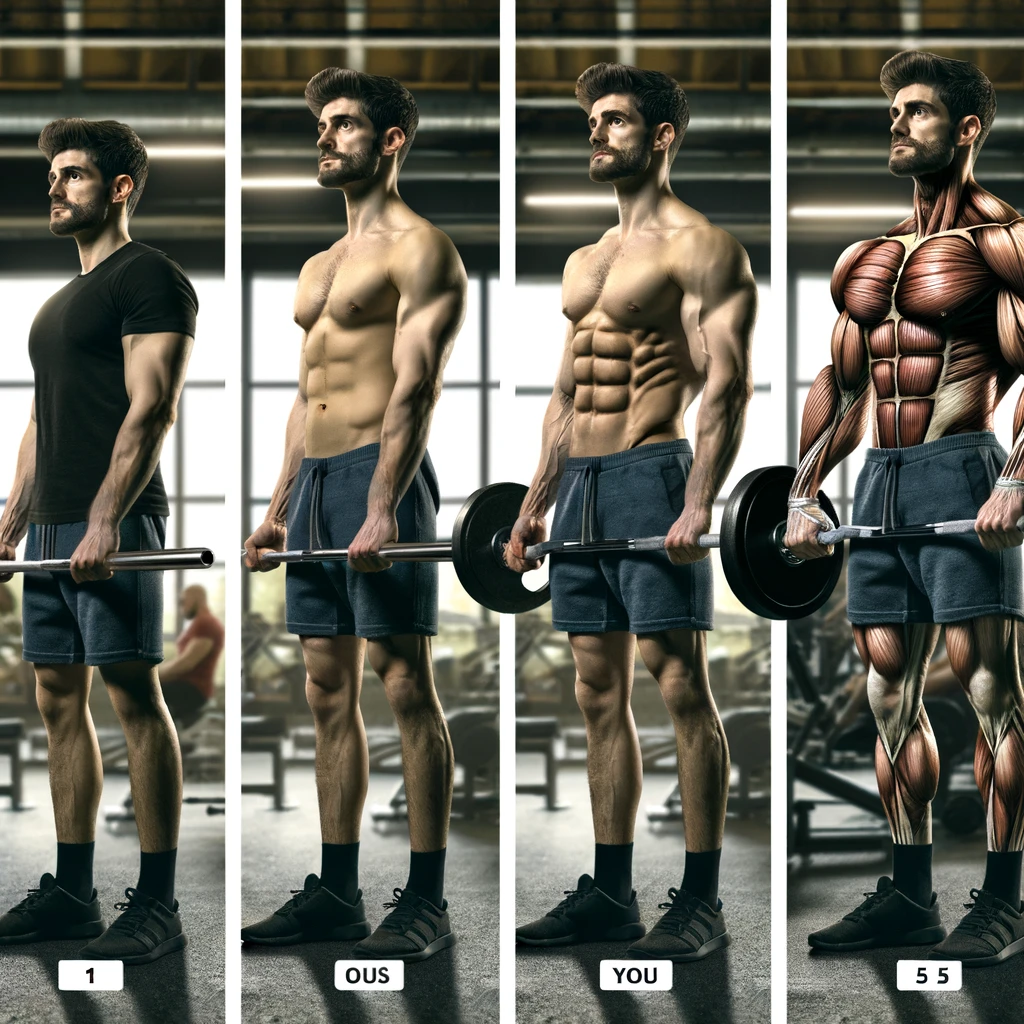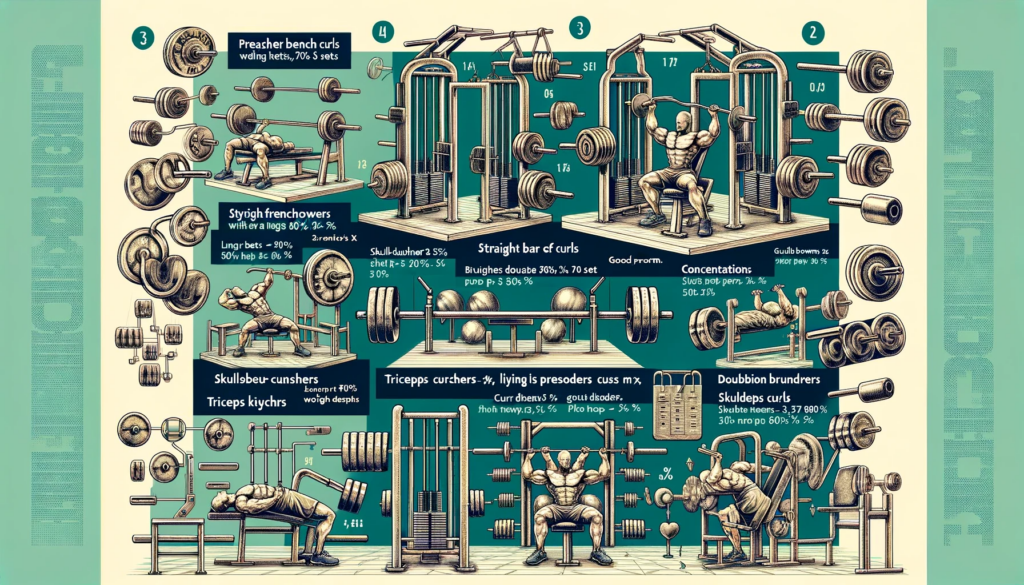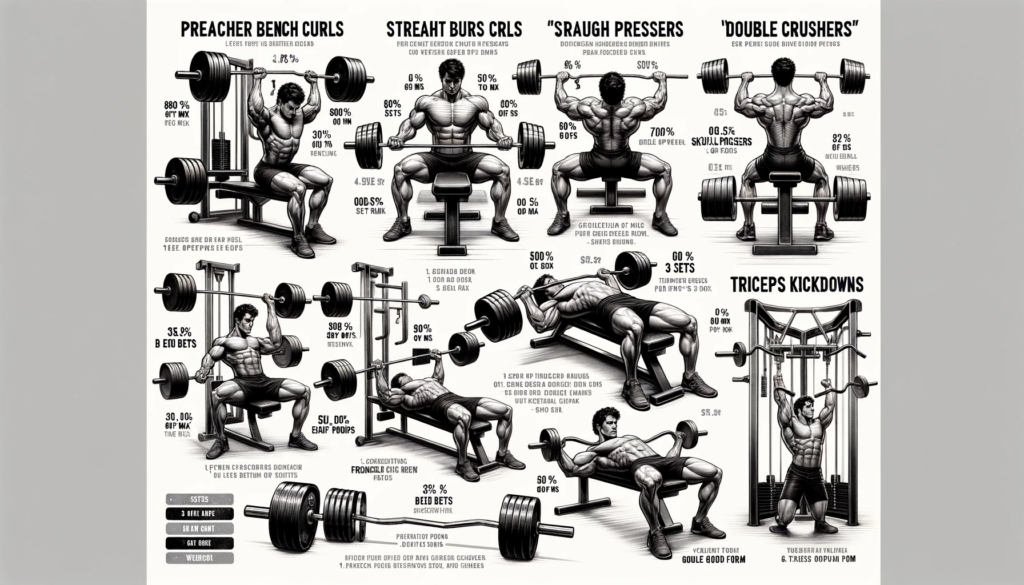Bodybuilding techniques were developed to overcome obstacles like hitting a plateau or feeling stuck, which often happens when you’re working out regularly. They’re basically just workout routines focused on making your muscles bigger.
These techniques are different from other types of workouts that aim to improve things like speed, balance, or flexibility. Here, we’re specifically talking about exercises that make your muscles grow (that’s called hypertrophy), along with strengthening the supporting structures like tendons, ligaments, and bones.
One popular idea you might hear in the gym is called progressive overload. It’s the notion that you have to keep increasing the weight you lift to keep growing your muscles. But realistically, doing that all the time would be tough – imagine huge guys bench-pressing ridiculous amounts! Progressive overload can work for a while, but it’s not the only way to train effectively.
Changing Your Routine’s

You should shake up your routine regularly, ideally every six weeks. This means not just changing the exercises you do, but also switching up how you do them. By constantly varying the stress on your muscles, you prevent them from getting too used to your workouts and encourage growth.
Mixing things up in the gym not only keeps things interesting but also promotes muscle growth by alternating between intense workouts (with heavy resistance and challenging exercises) and periods of recovery (with lighter activities and rest).
There are loads of terms out there for the same exercises and techniques. This isn’t a complete list by any means. There are plenty of other approaches and routines out there that aren’t mentioned here, used by different folks. If you’ve got some ideas, I’m all ears! I’m always eager to learn new techniques and training methods. Ideally, you’ll take what’s mentioned here and tweak it to suit your own goals, giving your muscles a real shock.
The suggested resistance levels and rest periods are just that – suggestions. Customizing the techniques to fit your own needs lets you create your own unique routine, adding variety to your workouts and keeping those muscles guessing!
The Giant Sets
A giant set involves performing several different exercises targeting the same body part in succession. You do one set of an exercise, then move directly to the next exercise, and so on. Typically, the weight used is moderate, and there’s little to no rest between each exercise. After completing one set of each exercise, take a rest of about two to three minutes. For instance, you might do a Close-Grip Bench Press, followed by Triceps Pushdowns, and then Dumbbell Kickbacks, all without pausing in between. This sequence constitutes one giant set.
Super Sets
A super set entails doing multiple exercises for two or more different body parts consecutively. You perform exercises for one body part, then immediately move on to exercises for another body part, and so forth. The weight used is generally moderate to heavy, with minimal rest between exercises. Rest periods between super sets typically range from two to five minutes. For example, in a Biceps and Triceps super set, you might do Alternating Standing Curls followed by Triceps French Curls without stopping in between.
Forced Reps
Forced reps involve pushing a muscle group to its limit during a set. This can mean using either maximal weight for fewer reps or lighter to moderate weight for higher reps. It’s crucial to have a lifting partner to assist in achieving full muscle contraction. There’s minimal rest between forced reps (as long as full contraction occurs), while rest between sets using forced reps is longer to allow for better recovery.
Example: Performing Bench Press at 90% of your max for 6 – 8 reps with the help of a partner for full contraction.
Eccentric Contractions (Negatives)
Eccentric contractions happen when a muscle lengthens instead of shortening (like in concentric contractions). This can be done intentionally, often with a partner and with heavier weight (around 30-40% more than your max), or it can be incorporated into any regular exercise routine by focusing on the ‘down’ phase of the lift.
The lifting pace during eccentric contractions is slow for control, with minimal rest between reps. However, more time is typically taken between sets for recovery.
Example: Lowering the barbell slowly to your chest during Bench Press with a weight exceeding your maximal lift, then returning the bar to the starting position with your partner’s assistance.
Twenty-Ones
Twenty-ones are based on the number of reps performed in a set. This method breaks the set into three segments, all within the same movement, each consisting of seven reps. These segments involve partial ranges of motion within the full range. After seven reps in one segment, you move to the next, until all three segments are completed (7 + 7 + 7 = 21!).
Moderate weight is used, and each segment of the movement is done consecutively with average rest between sets.
Example: Performing Standing Biceps Curls with seven partial reps from start to midway, followed by seven partial reps from midway to the end, and finally, seven full range of motion curls.
Timed Sets / Reps
Timed sets and reps involve performing a movement within a specific fixed time or count. Both the upward (concentric) and downward (eccentric) phases of the movement are completed over the specified time or count. The duration for both phases can be the same or different, as long as it’s consistent throughout the entire set. There’s minimal rest between reps (one follows the other), while rest between sets is moderate (2-3 minutes). Weight used is typically moderate to light, as the set can be challenging.
Example: Seated Quadriceps Extensions – Perform the upward movement over a 10-second count, followed by the downward movement over another 10-second count. Repeat.
Partial Reps
Partial reps, or restricted range of motion (ROM) sets, are similar to Twenty-ones but involve purposefully completing the entire set through a partial range of motion. Focus can be on either the upward (concentric) or downward (eccentric) portion of the partial movement. This can be done at any point within the normal full range of motion, such as the beginning, middle, or end. Weight is typically moderate to heavy, and rest between sets ranges from 1 to 2 minutes.
Example: Lying Hamstring Curls – Perform a set of 12 reps at the top of the normal range of motion, starting from fully contracted hamstrings and ending approximately midway through the normal range of motion. Repeat. This technique can also be applied to Bench Press and is a personal favourite.
Pre-Exhaustion
Pre-exhaustion involves isolating a muscle group with an isolating movement before performing a compound movement (which involves more than one muscle or joint). This fatigues the isolated muscle before engaging it in the compound exercise, maximizing its workload. Weight used is light to moderate, with reps usually in the higher range.
Example: For chest muscles – Perform Dumbbell Flyes (isolating movement) for three sets of 12-15 reps before moving on to Bench Press (compound movement).
Post-Exhaustion Sets
Post-exhaustion sets involve performing sets with low repetitions and heavy weights, followed immediately by sets with high repetitions and lighter weights. This can be done using the same exercise or two different exercises. There’s minimal to no rest between the heavy and light phases of the set, while rest between sets is moderate to long for recovery.
Example #1: Squats – Perform a heavy set of 4 to 6 reps, then immediately follow with a lighter set of Squats for 12 to 15 reps.
Example #2: Squats – Perform a heavy set of 4 to 6 reps, then immediately follow with Leg Extensions using moderate weight for 12 to 15 reps.
Pyramiding
Pyramiding is a term that encompasses various approaches, including load pyramiding, repetition pyramiding, and rest or intermission pyramiding.
Load Pyramiding: Each progressive set is done with heavier weight and fewer repetitions, with minimal or moderate rest between sets.
Example: Bench Press sets progressing as follows: Set 1 – 100lbs for 10 reps, Set 2 – 120lbs for 8 reps, and so on.
Load Sets: Weight is progressively added within a single set while the number of repetitions stays the same or decreases.
Example: One set of Bench Press starting at 100lbs for 10 reps, immediately followed by 120lbs for 8 reps, and so forth.
Also Read: Essential Exercises For Building Chest
Breakdowns Alongside Your Regular Routines

Breakdowns intensify workouts and can be incorporated into almost any exercise. They’re typically used alongside your regular routine. Here’s how it works:
- Warm up and perform a few sets of your usual routine.
- Load about 90% of your max onto the bar, approximately what you can lift for 2 unassisted reps.
- Bench Press the weight for 4 reps, getting assistance from your spotter as needed.
- Immediately after reracking the weight, strip off around 60% of it and continue benching, aiming for at least 8 reps.
- You need to remove a substantial amount of weight for this technique to be effective. If benching 150 lbs, remove enough weight to make a noticeable difference in resistance.
- In the final stage of a breakdown, you should be able to complete at least 6 reps unassisted to maximize effectiveness. Typically, two breakdown sets per exercise are sufficient.
Few More Tips
Combining the principles of Pre-Exhaustion with Breakdowns can challenge even the most experienced lifter. Here’s an example using the Bench Press: Grab a pair of 40 lb dumbbells for flies and another pair of 25 lb dumbbells. Load the bench with a weight you can normally lift for 12 reps. Begin with flies using the 40s until you reach failure. Drop the 40s, switch to the 25s, and aim for at least 8 reps.
After that, immediately grab the barbell loaded with 205 lbs (make sure your spotter is ready). Push out at least 4 reps. Still not enough? Strip off half the weight and continue lifting 100 lbs until complete failure, usually around the 5-rep mark. One or two sets like this per body part is typically sufficient (no more). Push your training partners to new levels with your intensity.
Related Content: The Ultimate Guide to Designing an Effective Workout Schedule
How Often Should You Train?
Three days per week of weight training is adequate. Pushing for more can actually yield less results. I’ve learned this the hard way. Training intensely seven days a week can lead to overtraining, resulting in negative outcomes. The goal is to work harder, not longer. Doing numerous sets of an exercise may improve your performance in that specific exercise, but it may not enhance the targeted body part as effectively as fewer, more intense sets.
This training approach should be balanced with sensible planning. Alternate between this intense training regimen for a week and your normal routine for another week, or rotate between both types of workouts. Always listen to your body. Rest is crucial. The body needs time to recover from the stress it’s been subjected to, sometimes requiring 2 or 3 days for full recovery. Even beginners can apply these techniques with positive results but always watch for signs of overtraining.
Below is a sample workout and suggestions for dividing your body to maximize these principles. Remember, exceptional effort leads to exceptional results. Train hard and enjoy the process.
Workout Plan 1

Monday: Chest & Back
- Bench Press: 3 sets with pre-exhaustion and Break-Down (as specified above).
- Incline Bench Press: 3 sets Break Down, 4-12 reps, 50-100% of max.
- Lat pull-downs: 3 sets of 4-12 reps, 50-80% of max. 2 sets of break-downs.
- Cable Rows: 3 sets of 4-12 reps, 50-80% of max. 2 sets of break-downs, reducing from 90% to 60% of max. 1 set double break-downs (fail, drop 60%, fail, drop 60%).
Wednesday: Shoulders & Legs
- Squats: 3 sets of 15-6 reps, 50-80% of max. 1 set of 30+ with warm-up weight.
- Leg Curls: 3 sets of 12-8 reps, 50-80% of max.
- Leg Extensions: 3 sets of 12-8 reps, 50-80% of max.
- Military Press: 5 sets of 12-8 reps, 50-80% of max. 3 sets pre-exhaustion using Lateral Dumbbell Raises first.
- Shoulder Shrugs: 2 sets 50-90% of max. 2 sets double break downs.
- Calf Raises: 3 sets of 20-10 reps, 50-90% of max. Break-downs on all sets.
Friday: Arms
- Preacher Bench Curls: 3 sets 15-8 reps, 80-50% of max.
- Straight Bar Curls: 3 sets all break downs.
- Concentration Curls: 2 sets of double break-downs.
- Lying French Presses (Skullcrushers): 1 set 8-15 reps, 50-70% of max. 2 sets of break downs.
- Triceps Pushdowns: 2 sets normal 15-6 reps, 50-80% of max.
- Triceps Kickbacks: 3 sets 10-12 reps WITH GOOD FORM.
Workout Plan 2

Monday: Chest & Back
- Bench Press: 3 sets with pre-exhaustion and Breakdown (as specified above).
- Incline Bench Press: 3 sets Break Down, 4-12 reps, 50-100% of max.
- Lat pull-downs: 2 sets of 4-12 reps and a breakdown, 50-80% of max.
- Dead Lifts: 2 sets of 15-10 slow reps (2-4 seconds up and 2-4 seconds down). Be cautious with this tempo to avoid injury.
Wednesday: Shoulders & Legs
- Squats: 3 sets of 15-30 reps, 50-80% of max.
- Leg Curls: 2 sets of 12-8 reps, 50-80% of max.
- Leg Extensions: 2 sets of 12-8 reps, 50-80% of max.
- Military Press: 3 sets of 12-8 reps, 50-80% of max. 2 sets pre-exhaustion using lateral dumbbell raises first.
- Shoulder Shrugs: 2 sets 50-90% of max. 2 sets double break downs.
- Calf Raises: 3 sets of 20-10 reps, 50-90% of max. Toes in + out on at least two of the sets.
Friday: Arms
- Chin-up: 1 set (30 sec up, 30 sec down) followed by Straight Bar Curls (8-12 reps), repeat cycle twice.
- Concentration Curls: 2 sets of double breakdowns.
- Dip: 1 set (30 sec up, 30 sec down) followed by Lying French Presses (Skullcrushers), repeat the cycle twice.
- Triceps Pushdowns: 2 sets normal 15-6 reps, 50-80% of max.
- Triceps Kickbacks: 1 set 10-12 reps WITH GOOD FORM.
These bodybuilding techniques break monotony and promote growth by alternating tissue breakdown and repair. Utilize them as described or customize them to fit your needs. Change them up, adjust weights and reps, and use them with different body parts on various days or weeks. Most importantly, stay focused on your goals and TRAIN HARD!

